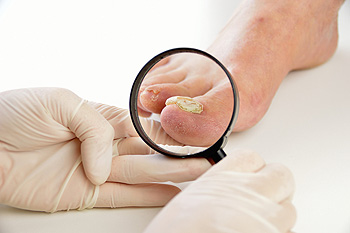
Fungal toenail infections are caused by fungi that thrive in warm, damp environments. These fungi often enter through small cracks in the nail or surrounding skin. Toenails are more frequently affected than fingernails, due to prolonged exposure to enclosed footwear. Symptoms of fungal toenails include thickening, yellow or white streaks, brittle texture, a distorted nail shape, or separation from the nail bed. Risk factors include diabetes, poor circulation, increased age, and frequent exposure to public pool areas. Nail injuries, a weakened immune system, and prolonged moisture around the toes are other risk factors. Wearing tight, enclosed shoes for extended periods may also encourage fungal growth. Diagnosis of the type of fungus requires lab testing or microscopic examination. Common types of toenail infections include distal subungual, white superficial, and proximal subungual, each affecting the nail differently. If you have developed a toenail infection, it is suggested that you make an appointment with a podiatrist for a diagnosis and proper treatment.
If left untreated, toenail fungus may spread to other toenails, skin, or even fingernails. If you suspect you have toenail fungus it is important to seek treatment right away. For more information about treatment, contact Wendy L. Grossman, DPM of New Jersey. Our doctor can provide the care you need to keep you pain-free and on your feet.
Symptoms
- Warped or oddly shaped nails
- Yellowish nails
- Loose/separated nail
- Buildup of bits and pieces of nail fragments under the nail
- Brittle, broken, thickened nail
Treatment
If self-care strategies and over-the-counter medications does not help your fungus, your podiatrist may give you a prescription drug instead. Even if you find relief from your toenail fungus symptoms, you may experience a repeat infection in the future.
Prevention
In order to prevent getting toenail fungus in the future, you should always make sure to wash your feet with soap and water. After washing, it is important to dry your feet thoroughly especially in between the toes. When trimming your toenails, be sure to trim straight across instead of in a rounded shape. It is crucial not to cover up discolored nails with nail polish because that will prevent your nail from being able to “breathe”.
In some cases, surgical procedure may be needed to remove the toenail fungus. Consult with your podiatrist about the best treatment options for your case of toenail fungus.
If you have any questions please contact our office located in Bloomfield, NJ . We offer the newest diagnostic and treatment technologies for all your foot and ankle needs.
